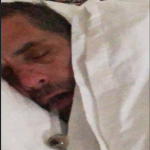You would think that someone could just design a throat stent like what they use for cardiovascular system only bigger ... then we could be like normal sleepers again ... that is what I would like to see.Goofproof wrote:XPAPS could be made with stronger specs, but as we see with the "M"agic, some people want smaller more lightweight units, not bigger, and building a higher flow XPAP, would require more weight, cost , size and noise level. Lots of people wouldn't see that as a improvement. Some of us would like to see the machine power upgraded.
Stupid question?
- DreamStalker
- Posts: 7509
- Joined: Mon Aug 07, 2006 9:58 am
- Location: Nowhere & Everywhere At Once
President-pretender, J. Biden, said "the DNC has built the largest voter fraud organization in US history". Too bad they didn’t build the smartest voter fraud organization and got caught.
That's kinda what pillar inserts intended. However, they seem to perform a "weak" or marginal stent. My guess is that more structurally rigid stenting may adversely affect swallowing and/or speech. But wow, am I once again out on a limb with my own wacky out-of-field guessing here.DreamStalker wrote: You would think that someone could just design a throat stent like what they use for cardiovascular system only bigger ... then we could be like normal sleepers again ... that is what I would like to see.
Eegads, I sure do remember them!!! I haven't even thought of them in a long time. Should I say thanks for the memories???
_________________
| Mask: Quattro™ FX Full Face CPAP Mask with Headgear |
| Additional Comments: PR SystemOne BPAP Auto w/Bi-Flex & Humidifier - EncorePro 2.2 Software - Contec CMS-50D+ Oximeter - Respironics EverFlo Q Concentrator |
Women are Angels. And when someone breaks our wings, we simply continue to fly.....on a broomstick. We are flexible like that.
My computer says I need to upgrade my brain to be compatible with its new software.
My computer says I need to upgrade my brain to be compatible with its new software.
Yes! And it might be worth noting that there has never been a reported case of apnea in one of those tiny magnetic terriers. This could be very promising biomed technology for those who don't indulge in high-iron diets...rooster wrote: Remember those little black and white Scottish terriers mounted on magnets?
Seriously, though, sounds interesting!
- neversleeps
- Posts: 1141
- Joined: Wed Apr 20, 2005 7:06 pm
- Location: Minnesota
Other possible future options:
or this:

I understand there is also promising research being conducted through animal testing for a new type of oral appliance:

http://www.putanendtosnoring.com/news.htm#3-7-06March 7, 2006: Looking for an ultra high-tech solution to snoring? The Institute for Biomedical Engineering at the University of Southern California (USC) has applied for a patent for a snoring cure involving injectable neuromuscular stimulators. The theory is simple: you snore when your soft palate relaxes during sleep. If you could maintain muscle tone at night, you may not snore. So, the patent describes a somewhat alarming method to make your muscles near your soft palate contract whenever you snore. The treatment will involve injecting small coils into the roof of your mouth. Then near your bed will be a larger coil connected to electricity (a battery?) and a microphone. When you snore, the microphone will trigger the coil to pulse, in turn charging the muscle coils, making the muscles contract. Pretty clever, eh? To our knowledge this solution is not currently available.
or this:
http://bme.case.edu/news/2003_1210.htmlThe tiny device underway at Case is designed to offer relief to those who find the current CPAP masks uncomfortable. It will consist of an electrode, several leads and a 3cm diameter stimulator and it will be surgically implanted below the ear in the neck where it will directly stimulate a targeted part of the hypoglossal nerve which controls movement of the muscles involved in maintaining the opening of the upper airways.

I understand there is also promising research being conducted through animal testing for a new type of oral appliance:













